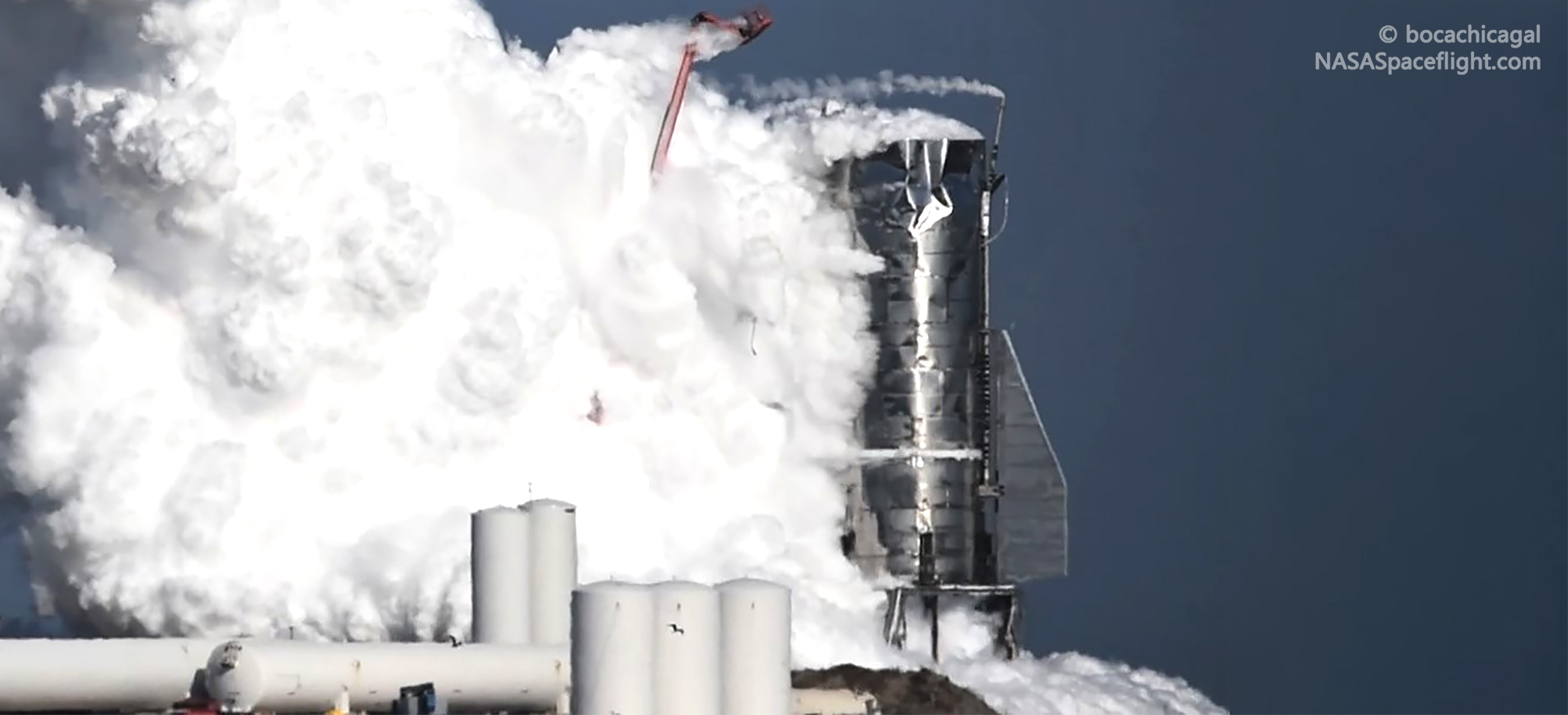

News
SpaceX Starship blew its top during rocket fueling test (updated)
Update: SpaceX has released an official statement indicating that Starship Mk1’s November 20th failure came after a decision to intentionally pressurize the rocket prototype to its limits. This likely means that the test was to max flight pressures and not an intentional burst test, so Starship’s dome failure is still a significant concern and was definitely not planned.
More importantly, SpaceX says that it had already decided to retire Starship Mk1 before any kind of flight testing, treating the vehicle as a pathfinder. Instead, SpaceX will build and use Starship Mk3 – the next Boca Chica prototype – for Starship’s first attempted skydiver-style landing and 20 km (12 mi) flight test.
SpaceX statement on the above test and incident: pic.twitter.com/r1ReRYhUhz— Michael Sheetz (@thesheetztweetz) November 21, 2019
SpaceX’s first full-scale Starship prototype has suffered a significant failure during testing, destroying or severely damaging large sections of the rocket. However, SpaceX CEO Elon Musk has already commented on the anomaly and is not all that concerned.
On November 20th, SpaceX – having canceled a planned road closure the day prior – unexpectedly requested a last-second road closure and entered into a much more serious round of testing with Starship Mk1, the rocket’s first full-scale prototype. This followed testing on November 18th that concluded with Starship Mk1’s very first ‘breath’ – some venting activity near the end of a tank proof test. SpaceX technicians spent the next 36 or so hours inspecting and working on Mk1, presumably looking for and patching minor leaks along its tank section.
The November 20th testing progressed far faster than the previous round of tests and Starship Mk1 was quickly venting again. Soon after that, frost began to appear on the exterior of its steel liquid oxygen and methane tanks, a telltale sign that some form of cryogenic testing was ongoing. Based on a distinct lack of activity at the nearby flare stack, SpaceX was using liquid oxygen (LOX) or liquid nitrogen (LN2) to verify that Starship performs as expected when filled with supercool propellant.
After initial venting and visible frost formation, SpaceX appeared to push forward, rapidly loading Starship Mk1 with LOX or LN2. This progress was easily visible thanks to the fact that the mass and pressure of all that cryogenic liquid made quick work of the slight imperfections on the exterior of Starship’s steel hull, turning the vehicle’s reflection from a speckled patchwork to an almost mirror-like finish. Roughly half an hour later, the otherwise peaceful scene was interrupted by the rapid failure of Starship Mk1’s upper LOX tank dome, instantly thrown several hundred feet into the air.
Seconds later, the crumpled upper half of Starship Mk1’s tank section appeared out of the clouds created and began hemorrhaging a huge volume of liquid oxygen, immediately boiling and vaporizing as it was exposed to the Earth’s comparatively white-hot atmosphere. Impressively, Starship appeared to remain functional after its top quite literally blew off, and the vehicle rapidly detanked and appeared to safe itself. Some ten minutes after the overpressure event, the freed liquid oxygen had boiled to nothing and Starship appeared to be quiet.
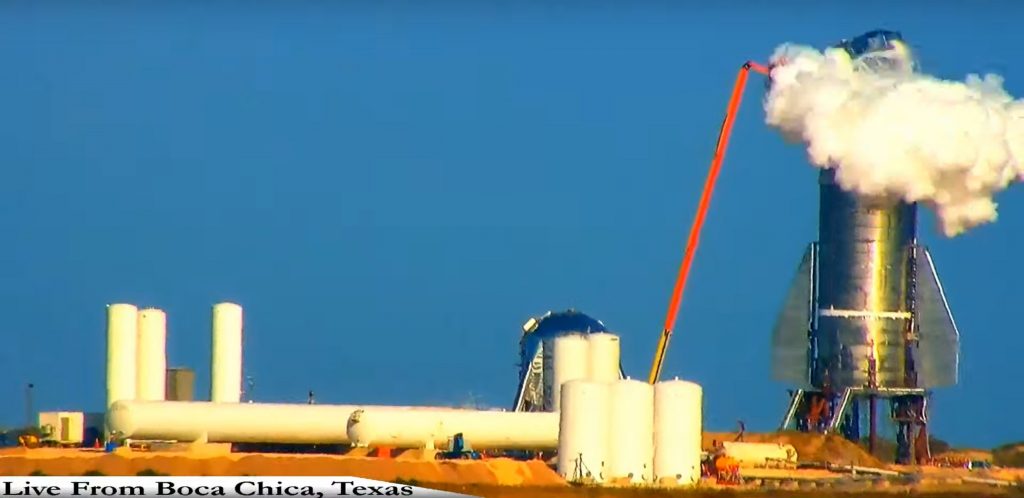
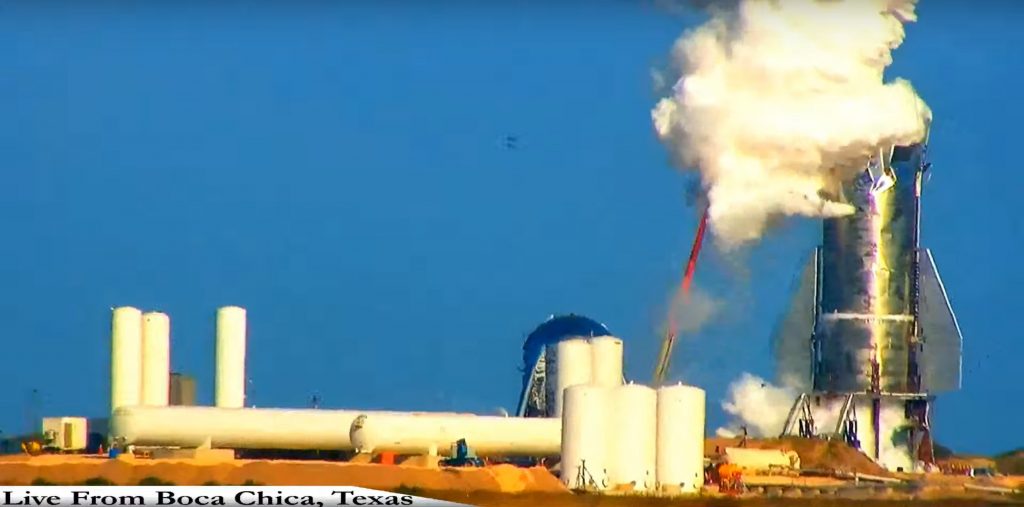
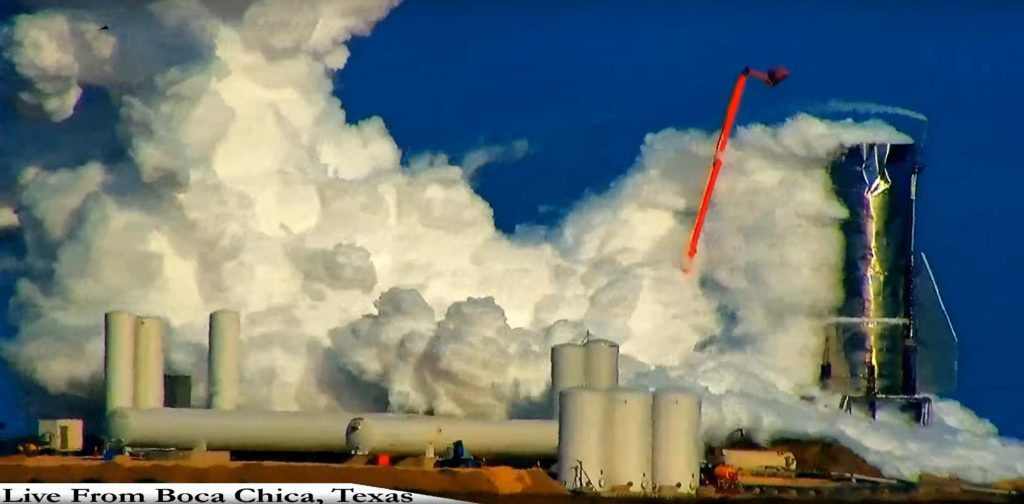
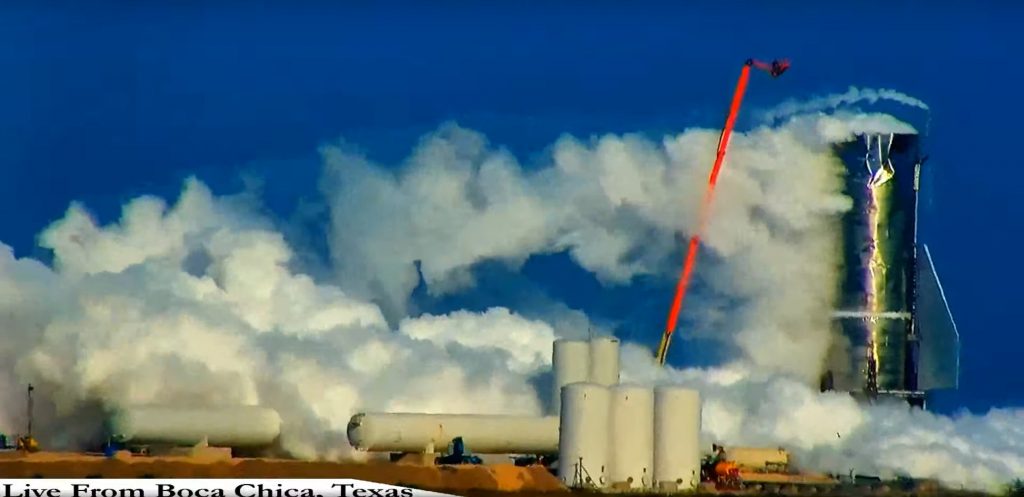
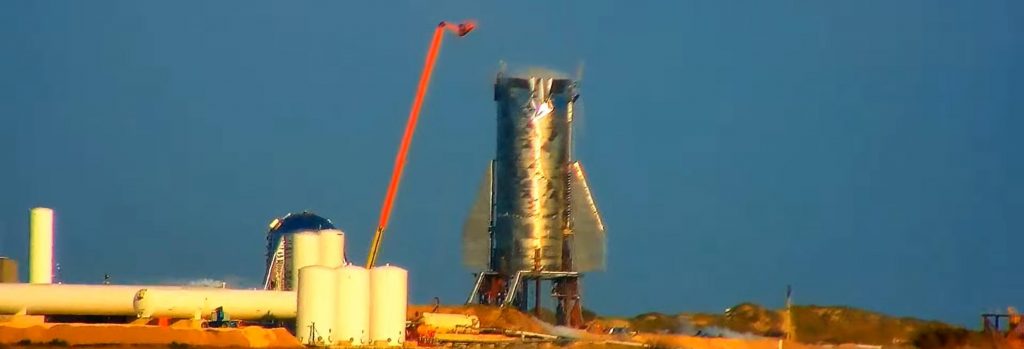
By all appearances, Starship Mk1 appeared to perform extremely well as an integrated system up to the point that its upper tank dome failed. The first frame from LabPadre’s stream with anything visibly amiss explicitly implicates the weld connecting the LOX dome to the cylindrical body of Starship’s LOX tank, point to a bad weld joint as the likeliest source of the failure. Although that hardware failure is unfortunate, Mk1’s loss will hopefully guide improvements in Starship’s design and manufacturing procedures.
Moving forward
Minutes after the anomaly was broadcast on several unofficial livestreams of SpaceX’s Boca Chica facilities, SpaceX CEO Elon Musk acknowledged Starship Mk1’s failure in a tweet, telegraphing a general lack of worry. Of note, Musk indicated that Mk1 was valuable mainly as a manufacturing pathfinder, entirely believable but also partially contradicting his September 2019 presentation, in which he pretty clearly stated that Mk1 would soon be launched to ~20 km to demonstrate Starship’s exotic new skydiver landing strategy.
Musk says that instead of repairing Starship Mk1, SpaceX’s Boca Chica team will move directly to Starship Mk3, a significantly more advanced design that has benefitted from the numerous lessons learned from building and flying Starhopper and fabricating Starship Mk1. The first Starship Mk3 ring appears to have already been prepared, but SpaceX’s South Texas focus has clearly been almost entirely on preparing Starship Mk1 for wet dress rehearsal, static fire, and flight tests. After today’s failure, it sounds like Mk1 will most likely be retired early and replaced as soon as possible by Mk3.
Above all else, the most important takeaway from today’s Starship Mk1 anomaly is that the vehicle was a very early prototype and SpaceX likely wants to have vehicle failures occur on the ground or in-flight. As long as no humans are at risk, pushing Starship to failure (or suffering unplanned failures like today’s) can only serve to benefit and improve the vehicle’s design, especially when the failed hardware can be recovered intact (ish) and carefully analyzed.
A step further, SpaceX is simultaneously building a second (and third) Starship prototype at its companion Cocoa, Florida facilities, and Starship Mk2 is nearly finished. Coincidentally, technicians installed its last tank dome – the same dome that failed on Mk1 – just days ago, and any insight that the Boca Chica team can gather from Mk1’s troubles will almost certainly be applied to Mk2, whether that means reinforcing its existing domes or fully replacing the upper dome with an improved design.
Check out Teslarati’s Marketplace! We offer Tesla accessories, including for the Tesla Cybertruck and Tesla Model 3.
News
Tesla UK sales see 14% year-over-year rebound in June: SMMT data
The SMMT stated that Tesla sales grew 14% year-over-year to 7,719 units in June 2025.

Tesla’s sales in the United Kingdom rose in June, climbing 14% year-over-year to 7,719 units, as per data from the Society of Motor Manufacturers and Traders (SMMT). The spike in the company’s sales coincided with the first deliveries of the updated Model Y last month.
Model Y deliveries support Tesla’s UK recovery
Tesla’s June performance marked one of its strongest months in the UK so far this year, with new Model Y deliveries contributing significantly to the company’s momentum.
While the SMMT listed Tesla with 7,719 deliveries in June, independent data from New AutoMotive suggested that the electric vehicle maker registered 7,891 units during the month instead. However, year-to-date figures for Tesla remain 2% down compared to 2024, as per a report from Reuters.
While Tesla made a strong showing in June, rivals are also growing. Chinese automaker BYD saw UK sales rise nearly fourfold to 2,498 units, while Ford posted the highest EV growth among major automakers, with a more than fourfold increase in the first half of 2025.
Overall, the UK’s battery electric vehicle (BEV) demand surged 39% to to 47,354 units last month, helping push total new car sales in the UK to 191,316 units, up 6.7% from the same period in 2024.
EV adoption accelerates, but concerns linger
June marked the best month for UK car sales since 2019, though the SMMT cautioned that growth in the electric vehicle sector remains heavily dependent on discounting and support programs. Still, one in four new vehicle buyers in June chose a battery electric vehicle.
SMMT Chief Executive Mike Hawes noted that despite strong BEV demand, sales levels are still below regulatory targets. “Further growth in sales, and the sector will rely on increased and improved charging facilities to boost mainstream electric vehicle adoption,” Hawes stated.
Also taking effect this week was a new US-UK trade deal, which lowers tariffs on UK car exports to the United States from 27.5% to 10%. The agreement could benefit UK-based EV producers aiming to expand across the country.
News
Tesla Model 3 ranks as the safest new car in Europe for 2025, per Euro NCAP tests
Despite being on the market longer than many of its rivals, the Tesla Model 3 continues to set the bar for vehicle safety.

The Tesla Model 3 has been named the safest new car on sale in 2025, according to the latest results from the Euro NCAP. Among 20 newly tested vehicles, the Model 3 emerged at the top of the list, scoring an impressive 359 out of 400 possible points across all major safety categories.
Tesla Model 3’s safety systems
Despite being on the market longer than many of its rivals, the Tesla Model 3 continues to set the bar for vehicle safety. Under Euro NCAP’s stricter 2025 testing protocols, the electric sedan earned 90% for adult occupant protection, 93% for child occupant protection, 89% for pedestrian protection, and 87% for its Safety Assist systems.
The updated Model 3 received particular praise for its advanced driver assistance features, including Tesla’s autonomous emergency braking (AEB) system, which performed well across various test scenarios. Its Intelligent Speed Assistance and child presence detection system were cited as noteworthy features as well, as per a WhatCar report.
Other notable safety features include the Model 3’s pedestrian-friendly pop-up hood and robust crash protection for both front and side collisions. Euro NCAP also highlighted the Model 3’s ability to detect vulnerable road users during complex maneuvers, such as turning across oncoming traffic.
Euro NCAP’s Autopilot caution
While the Model 3’s safety scores were impressive across the board, Euro NCAP did raise concerns about driver expectations of Tesla’s Autopilot system. The organization warned that some owners may overestimate the system’s capabilities, potentially leading to misuse or inattention behind the wheel. Even so, the Model 3 remained the highest-scoring vehicle tested under Euro NCAP’s updated criteria this year.
The Euro NCAP’s concerns are also quite interesting because Tesla’s Full Self-Driving (FSD) Supervised, which is arguably the company’s most robust safety suite, is not allowed for public rollout in Europe yet. FSD Supervised would allow the Model 3 to navigate inner city streets with only minimal human supervision.
Other top scorers included the Volkswagen ID.7, Polestar 3, and Geely EX5, but none matched the Model 3’s total score or consistency across categories. A total of 14 out of 20 newly tested cars earned five stars, while several models, including the Kia EV3, MG ZS, and Renault 5, fell short of the top rating.
Elon Musk
Why Tesla’s Q3 could be one of its biggest quarters in history
Tesla could stand to benefit from the removal of the $7,500 EV tax credit at the end of Q3.

Tesla has gotten off to a slow start in 2025, as the first half of the year has not been one to remember from a delivery perspective.
However, Q3 could end up being one of the best the company has had in history, with the United States potentially being a major contributor to what might reverse a slow start to the year.
Earlier today, the United States’ House of Representatives officially passed President Trump’s “Big Beautiful Bill,” after it made its way through the Senate earlier this week. The bill will head to President Trump, as he looks to sign it before his July 4 deadline.
The Bill will effectively bring closure to the $7,500 EV tax credit, which will end on September 30, 2025. This means, over the next three months in the United States, those who are looking to buy an EV will have their last chance to take advantage of the credit. EVs will then be, for most people, $7,500 more expensive, in essence.
The tax credit is available to any single filer who makes under $150,000 per year, $225,000 a year to a head of household, and $300,000 to couples filing jointly.
Ending the tax credit was expected with the Trump administration, as his policies have leaned significantly toward reliance on fossil fuels, ending what he calls an “EV mandate.” He has used this phrase several times in disagreements with Tesla CEO Elon Musk.
Nevertheless, those who have been on the fence about buying a Tesla, or any EV, for that matter, will have some decisions to make in the next three months. While all companies will stand to benefit from this time crunch, Tesla could be the true winner because of its sheer volume.
If things are done correctly, meaning if Tesla can also offer incentives like 0% APR, special pricing on leasing or financing, or other advantages (like free Red, White, and Blue for a short period of time in celebration of Independence Day), it could see some real volume in sales this quarter.
You can now buy a Tesla in Red, White, and Blue for free until July 14 https://t.co/iAwhaRFOH0
— TESLARATI (@Teslarati) July 3, 2025
Tesla is just a shade under 721,000 deliveries for the year, so it’s on pace for roughly 1.4 million for 2025. This would be a decrease from the 1.8 million cars it delivered in each of the last two years. Traditionally, the second half of the year has produced Tesla’s strongest quarters. Its top three quarters in terms of deliveries are Q4 2024 with 495,570 vehicles, Q4 2023 with 484,507 vehicles, and Q3 2024 with 462,890 vehicles.
-

 Elon Musk4 days ago
Elon Musk4 days agoTesla investors will be shocked by Jim Cramer’s latest assessment
-

 News1 week ago
News1 week agoTesla Robotaxi’s biggest challenge seems to be this one thing
-

 Elon Musk2 weeks ago
Elon Musk2 weeks agoFirst Look at Tesla’s Robotaxi App: features, design, and more
-

 News2 weeks ago
News2 weeks agoSpaceX and Elon Musk share insights on Starship Ship 36’s RUD
-

 News2 weeks ago
News2 weeks agoWatch Tesla’s first driverless public Robotaxi rides in Texas
-

 News1 week ago
News1 week agoWatch the first true Tesla Robotaxi intervention by safety monitor
-

 News2 weeks ago
News2 weeks agoTesla has started rolling out initial round of Robotaxi invites
-

 Elon Musk2 weeks ago
Elon Musk2 weeks agoTesla to launch in India in July with vehicles already arriving: report

















